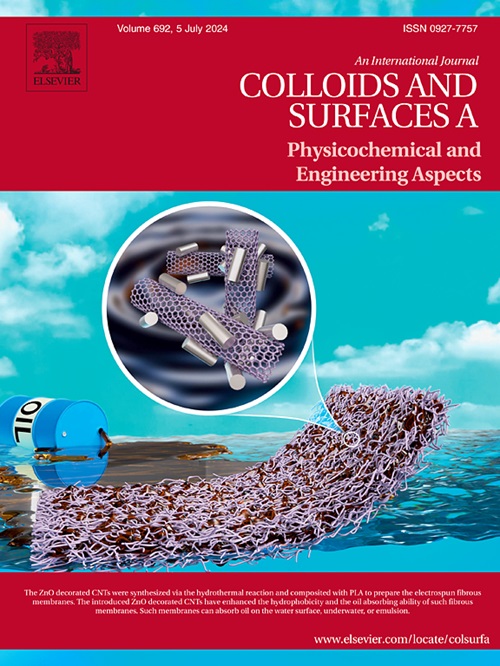可注射聚乙二醇/壳聚糖原位水凝胶,具有良好的机械性能,用于伤口敷料
IF 4.9
2区 化学
Q2 CHEMISTRY, PHYSICAL
Colloids and Surfaces A: Physicochemical and Engineering Aspects
Pub Date : 2025-07-23
DOI:10.1016/j.colsurfa.2025.137841
引用次数: 0
摘要
为了提高壳聚糖的水溶性,提高壳聚糖基原位水凝胶的机械强度,以六亚甲基二异氰酸酯(HDI)为桥接剂,采用简单高效的改性方法制备了聚乙二醇单甲基醚接枝壳聚糖(PCS),然后以端醛聚乙二醇(DF-PEG)为交联剂,制备了一系列聚乙二醇/壳聚糖基原位水凝胶(PCS@gel)。所得PCS在无酸条件下具有良好的水溶性,固含量可达8 wt%。通过研究PCS与DF-PEG的质量比及其固含量对PCS@gel凝胶时间和性能的影响,结果表明,增加前驱体溶液的固含量可以显著缩短凝胶时间,提高其力学性能和粘附强度。当PCS与DF-PEG的质量比为1:1时,PCS@gel的凝胶时间更短,机械强度更高。当PCS与DF-PEG的质量比为5:1时,PCS@gel具有更好的粘附性能。此外,PCS@gel还具有良好的自愈能力、抗菌作用、低细胞毒性和促进细胞迁移的能力。因此,PCS@gel作为伤口敷料将有很好的应用前景。本文章由计算机程序翻译,如有差异,请以英文原文为准。
Injectable poly(ethylene glycol)/chitosan-based in situ hydrogel with wonderful mechanical property for wound dressing
To increase the water solubility of chitosan and enhance the mechanical strength of chitosan-based in-situ hydrogel, poly(ethylene glycol) monomethyl ether-grafted chitosan (PCS) was fabricated by a simple and efficient modification method with hexamethylene diisocyanate (HDI) as bridging agent, and then a series of poly(ethylene glycol)/chitosan-based in situ hydrogels (PCS@gel) were prepared from PCS and aldehyde-terminated poly(ethylene glycol) (DF-PEG) as cross-linking agent. The resultant PCS shows good water solubility in the absence of acid and its solid content is up to 8 wt%. By studying the effects of the mass ratio of PCS to DF-PEG and their solid content on the gel time and properties of PCS@gel, the results demonstrate that increasing the solid content of precursor solution can significantly shorten the gel time and improve its mechanical properties and adhesion strength. When the mass ratio of PCS to DF-PEG is 1:1, PCS@gel has a shorter gel time and higher mechanical strength. While the mass ratio of PCS to DF-PEG is 5:1, PCS@gel has better adhesion properties. Besides, PCS@gel also has good self-healing ability, antibacterial effect, low cytotoxicity and the ability to promote cell migration. Therefore, PCS@gel will have a promising application as a wound dressing.
求助全文
通过发布文献求助,成功后即可免费获取论文全文。
去求助
来源期刊
CiteScore
8.70
自引率
9.60%
发文量
2421
审稿时长
56 days
期刊介绍:
Colloids and Surfaces A: Physicochemical and Engineering Aspects is an international journal devoted to the science underlying applications of colloids and interfacial phenomena.
The journal aims at publishing high quality research papers featuring new materials or new insights into the role of colloid and interface science in (for example) food, energy, minerals processing, pharmaceuticals or the environment.

 求助内容:
求助内容: 应助结果提醒方式:
应助结果提醒方式:


